North Carolina is famous for its rich avifauna – there are almost 480 bird species there with a number of those being very active during the night!
Examples of nocturnal birds in North Carolina include the common nighthawk, American robin, black-crowned night heron, barred owl, northern mockingbird, and many others.
Do some of them sound familiar? Let’s jump in and see what each of these looks and sounds like!
Table of Contents
Night Birds In NC
1. American Woodcock

- Scientific Name: Scolopax minor
American woodcocks, small elusive birds, can be heard in NC from dusk to dawn. Look for them in fields near forests, especially around powerline cuts.
They’re challenging to spot due to their nocturnal habits and camouflaged colors. Listen for their distinctive “peent” call on the ground or twittering in the air.
American Woodcock Call | Source: Jonathon Jongsma, CC BY-SA 3.0, via Wikimedia Commons
Read More: List of night birds in Tennessee
2. Wilson’s Snipe
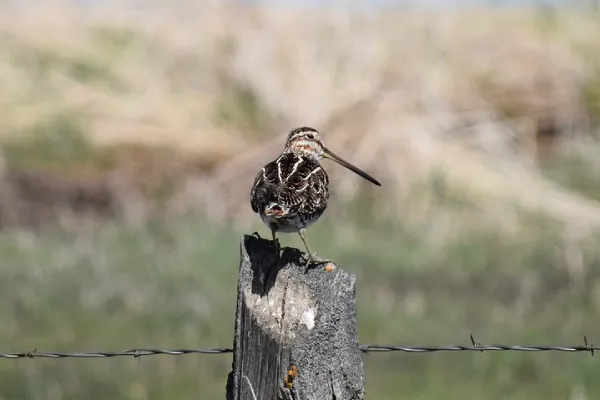
- Scientific Name: Gallinago delicata
Like American woodcocks, Wilson’s snipes are found in NC. They prefer wet fields, marshes, and bogs, residing there during winter. Look for them at dawn and dusk.
Recognize them by their “tuk-tuk” call from the ground. They have an intriguing winnowing display flight, creating distinct sounds in the air. Males fly high in circles, then dive, producing longer-lasting sounds. You can observe this behavior both day and night.
Wilson’s Snipe Call | Source: Doug Hynes, CC BY-SA 4.0, via Wikimedia Commons
They are also common in Louisiana; check out other night birds heard there in this article.
3. Eastern Screech-Owl

- Scientific Name: Megascops asio
Eastern screech owls are small, stocky, and strictly nocturnal. They live in North Carolina’s woodlands near water and lower elevations year-round.
They’re most vocal near sunset, becoming quieter later at night. Calls increase around full moons and before storms. Listen for the “whinny” and trilling tremolo calls. In summer (June-August), watch for juvenile hissing sounds.
Eastern Screech-owl Call | Source: Jonathon Jongsma, CC BY-SA 3.0, via Wikimedia Commons
Read More: What birds sing at night in Oregon?
4. Great Horned Owl

- Scientific Name: Bubo virginianus
Great horned owls, one of North Carolina’s largest birds, can be heard singing mainly after dark and before dawn. These permanent residents of the state prefer open areas near forests and make deep, loud “ho-ho-hoo hoo hoo” sounds.
Great Horned Owl Call | Source: Michael & Katie LaTour, CC BY-SA 4.0, via Wikimedia Commons
Females have higher-pitched calls, peaking after midnight. They may sing in duets in winter or spring and have distinctive juvenile begging calls in summer, sometimes resembling barn owls’ calls.
These owls are also one of the many examples of nocturnal animals found in NC.
5. Barn Owl
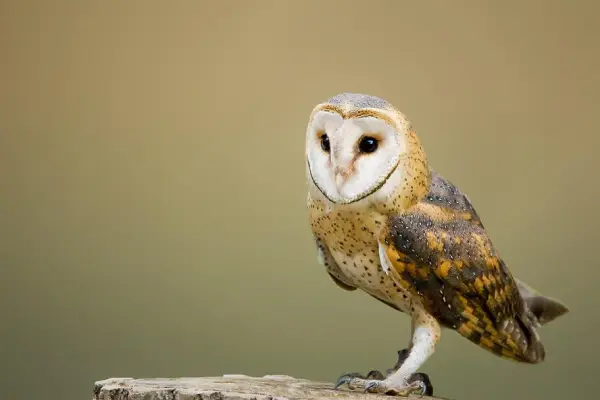
- Scientific Name: Tyto alba
One of the most widely distributed species of owl in the world, barn owls are permanent residents of NC.
These medium-sized owls often have a “ghostly” appearance, especially if seen at night, around open habitats, including grasslands, marshes, and agricultural areas.
Barn owls do not hoot and make bone-chilling screams instead. They hunt for rodents during the night and roost in nest boxes, caves, tree hollows, and old buildings.
Barn Owl Call | Source: Luis Gracia, CC BY-SA 4.0, via Wikimedia Commons
They are quite common in the USA and are among many birds seen and heard during the night in Florida.
6. Barred Owl
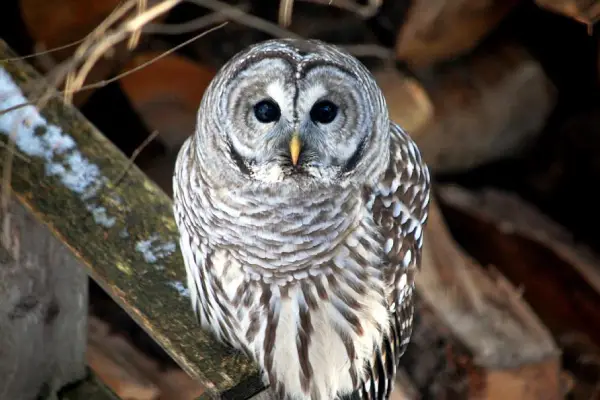
- Scientific Name: Strix varia
Barred owls are year-round North Carolina residents, found in dense forests near water. They’re active at night, known for their “who-cooks-for-you” song and “hoo-ahhh” calls, often in duets.
Barred Owl Call | Source: Jonathon Jongsma, CC BY-SA 4.0, via Wikimedia Commons
Juveniles have a unique high-pitched raspy hissing sound. These massive owls have mottled brown and white plumage.
7. Short-eared Owl

- Scientific Name: Asio flammeus
Short-eared owls, widely distributed worldwide except in Antarctica and Australia, visit North Carolina during winter. They’re often heard in open grasslands, including fields, marshes, and even airports.
These owls have striking yellow eyes with black rings, resembling mascara. While usually quiet, they produce “voo-hoo-hoo” calls.
Short-eared Owl Call | Source: Jamescandless, CC BY-SA 3.0, via Wikimedia Commons
They are mostly nocturnal but can be crepuscular and occasionally diurnal.
Read More: Some examples of birds singing at night in Michigan
8. Northern Saw-whet Owl

- Scientific Name: Aegolius acadicus
Northern saw-whet owls are nonbreeding residents of the state in small numbers during winter.
Northern saw-whet owls were named after their loud and repetitive whistles described as “a saw being sharpened on a whetstone”. Their calling peaks around 2 hours after sunset and decreases until just before sunrise.
Listen for the tooting advertising song of males, a repeated “toot-toot-toot.” They give a variety of other calls, and later in the season, juveniles produce a raspy, hissing call.
The compound called porphyrin makes their flight feathers unique – the pigment gives their feathers a neon pink fluorescence when exposed to UV light.
9. Pied-billed Grebe

- Scientific Name: Podilymbus podiceps
Pied-billed grebes, small and stocky water birds, are common in North Carolina’s marshes and ponds with emergent vegetation. Active at night, they produce loud, whooping, cuckoo-like songs, often duetting with their mate.
Their brown plumage, darkening on the crown and back, provides effective camouflage, making them a bit challenging to spot.
Read More: List of common night birds of Oklahoma
10. Eastern Whip-poor-will
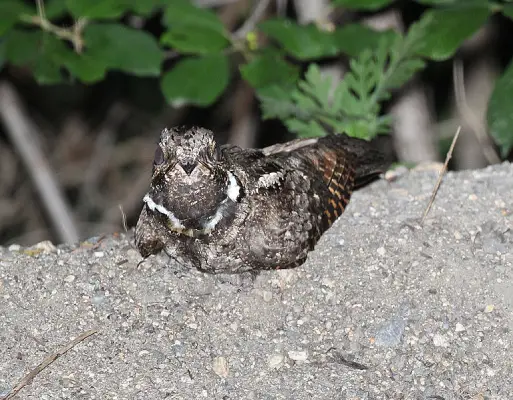
- Scientific Name: Antrostomus vociferus
Eastern whip-poor-wills visit northern NC during the breeding season and coastal areas in winter, migrating through the rest of the state. These cryptic nocturnal birds are heard more than seen.
They hide during the day, typically in pine barrens and forest openings. At dawn and dusk, they sing their famous “whip-poor-will” song.
Eastern whip-poor-will Call | Source: G. McGrane, Public domain, via Wikimedia Commons
They hunt at night, catching flying insects from the ground. Similar to common nighthawks, their distinctive call helps differentiate the two.
11. Common Nighthawk

- Scientific Name: Chordeiles minor
During the summer breeding season in North Carolina, common nighthawks can be heard singing at dawn and dusk. These medium-sized raptors with split tails and long wings can be found in prairies, forests, savannahs, and urban areas.
These birds create a distinct peent sound and perform courtship displays with rapid dives that produce a booming sound as air rushes over their wings.
Common Nighthawk Call | Source: Unknown author, Public domain, via Wikimedia Commons
Common nighthawks are well-camouflaged during the day, with gray, black, and brown plumage and white patches near the base of their primary feathers.
12. Chuck-will’s-widow
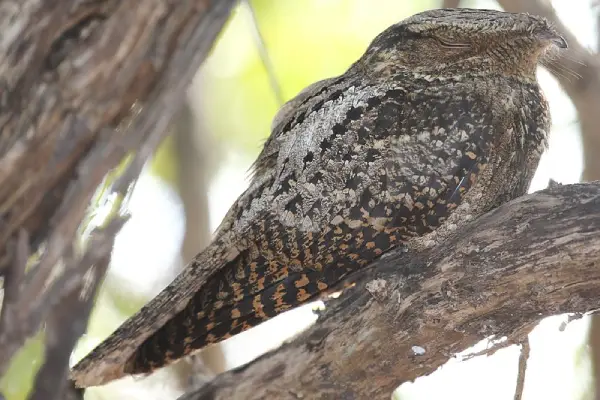
- Scientific Name: Antrostomus carolinensis
Chuck-will’s-widows are large night birds with big heads, short bills, and elongated tails. Their plumage varies from grayish to rufous with intricate patterns, camouflaging them well in the trees.
Chuck-will’s-widows are found in pine barrens and edges of swamps. They sing their “chuck-will’s-widow” songs, with males being most active in April-May, quieter in June, and more vocal again in July and August. Singing may continue all night on days of a full or near-full moon.
Chuck-will’s-widow Call | Source: James G. Howes, Public domain, via Wikimedia Commons
You might have spotted them in your headlights while driving as they love to sit on the roads and roadsides at night.
13. Common Gallinule

- Scientific Name: Gallinula galeata
Common gallinules are medium-sized marsh birds with dark plumage, white undertails, red frontal plates on their heads, and distinctive long legs and toes.
In the northern parts of the state, they are summer residents, while in the south, they stay year-round. These birds prefer freshwater wetlands with open water and emergent vegetation.
They are most active during dawn and dusk, becoming more vocal from April to June during the breeding season. Listen for their “marsh chicken sound” and single “clucks,” which are their most commonly heard calls.
14. American Coot
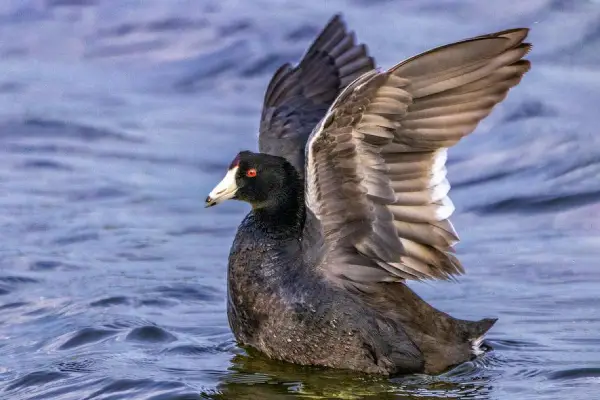
- Scientific Name: Fulica americana
American coots are small water birds with black plumage, bright white beaks, red eyes, and yellow-green legs.
Although they resemble ducks, American coots are only distantly related to them. These winter residents of North Carolina can be seen and heard in freshwater wetlands with open water and emergent vegetation around dawn and dusk.
They produce a sharp “poot” call and a screeching “kree” sound, and they are particularly noisy swimmers, so you may also recognize them by splashing water sounds.
15. Clapper Rail

- Scientific Name: Rallus crepitans
Clapper rails are large brown birds found along the Atlantic coasts of the eastern United States, eastern Mexico, and some Caribbean islands. Nocturnal and somewhat secretive, these chicken-sized birds rarely fly and have grayish-brown plumage with orange bills that curve downwards.
In North Carolina, clapper rails can be heard fairly commonly throughout the coastal area year-round. They are most active at dawn and dusk with mated pairs singing together in the evening and slightly less during the morning hours.
Listen to the male’s repeated “kek” calls and grunt or “clapper” calls that pairs use to communicate. When one bird begins to sing, neighboring birds usually join in.
Clapper rails have 4-16 creamy white eggs that have brownish blotches that both parents incubate; males will incubate them at night.
Read More: What birds sing at night in CT?
16. Virginia Rail

- Scientific Name: Rallus limicola
Virginia rails are compact aquatic birds commonly heard in coastal parts of North Carolina during winter nights. They are found around wetlands with cattails, where they often make harsh “kuk-kuk-kuk” calls; their “grunt” calls can be used for communication between mates.
They are often found together with soras; short-billed soras feed on seeds, while the long-billed Virginia rails mostly consume insects.
Read More: Examples of Virginia’s most common night birds
17. Sora

- Scientific Name: Porzana carolina
Soras are small waterbirds found in coastal parts of the state. They are winter residents in NC and can be identified by their short yellow beaks, dark-marked brown upperparts, blue-gray faces and underparts, and black and white barrings on the flanks.
Soras are common around wetlands containing cattails and patches of open water; their descending “whinny” call is used by mated pairs and when establishing territories. They also have a “ker-wee” call for attracting mates and are most active during dawn and dusk.
Sora Call | Source: Jonathon Jongsma, CC BY-SA 3.0, via Wikimedia Commons
The best times to spot soras are early in the mornings or late in the evenings when they’re more likely to come out from the thick plants in search of food.
18. American Bittern

- Scientific Name: Botaurus lentiginosus
American bitterns are well-camouflaged solitary birds that winter throughout most of NC before departing north to breed. These birds prefer large cattail or sedge marshes and wet meadows.
More often heard than seen, they are mainly nocturnal with most of the activity happening around dusk. American bitterns have a distinctive booming call that resembles a congested pump that people describe as “oong-kach-oonk.“
American Bittern Call | Source: Alejandro Erickson, CC BY-SA 3.0, via Wikimedia Commons
Read More: Examples of Ohio’s most common nocturnal birds
19. Least Bittern

- Scientific Name: Ixobrychus exilis
Least bitterns are one of the smallest heron species in the world. They can be heard in NC during their breeding season from May to August; they are more active at dawn and dusk and less vocal in windy or rainy conditions.
Least bitterns are common around marshes with a mix of open water and vegetation, often with cattails, phragmites, or lily pads. Males can be recognized by their soft “coo-coo-coo” and “reek-reek-reek” calls.
Least Bittern Call | Source: Niels Krabbe, CC BY-SA 3.0, via Wikimedia Commons
Identify them also by their long legs, daggerlike bills, and orange, black, and white plumage.
20. Black-crowned Night Heron
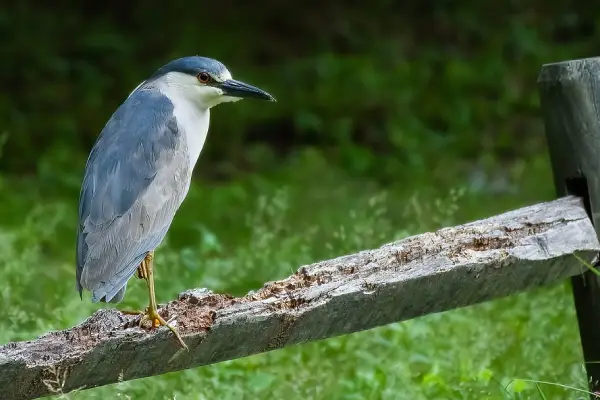
- Scientific Name: Nycticorax nycticorax
Black-crowned night herons visit central and northern NC during summer breeding, with some southern coastal populations staying year-round. They can be heard around wooded swamps, ponds, lakes, and mangroves.
Unlike many other herons, they’re active at night or dusk and migrate in flocks during the night. Their name “Nycticorax” means “night raven” in Greek, reflecting their nocturnal habits and crow-like calls.
Black-crowned Night Heron Call | Source: Jonathon Jongsma, CC BY-SA 3.0, via Wikimedia Commons
These herons often bait fish, luring prey with thrown food before striking with their long beaks.
21. Yellow-crowned Night Heron

- Scientific Name: Nyctanassa violacea
Yellow-crowned night herons, named for their pale yellow crowns, are heard at night in coastal NC during summer. They are vocal, with various calls like “quawk,” “yup-yup,” and “huh.”
While occasionally seen during the day, they are primarily nocturnal, roosting in trees during daylight and feeding at night, with crabs and crayfish being their main prey.
22. Northern Mockingbird
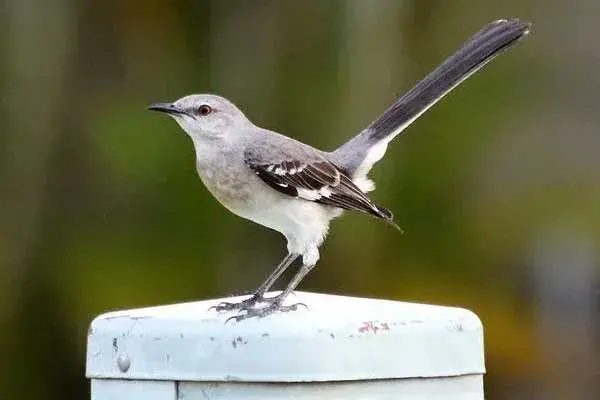
- Scientific name: Mimus polyglottos
Northern mockingbirds are birds most often heard during the night in North Carolina. To reduce their constantly annoying singing, consider using bird nets on trees or placing cardboard cutouts of predators like hawks or owls.
These birds are year-round residents in NC and are aptly named, as they can mimic over 200 different songs and imitate up to 35 species.
Their mimicry extends to sounds like rusty hinges, car alarms, cackling hens, and dog barks, sometimes indistinguishable even with electronic analysis.
Read More: What birds can you hear chirping at night in Texas?
23. Yellow-breasted Chat

- Scientific Name: Icteria virens
Yellow-breasted chats can be often heard singing in the morning and evening during summer in North Carolina. They will also even sing at night during the height of their breeding season (May to July).
Often heard than seen, they are common around dense, brushy areas and hedgerows. These birds have a unique mix of cackles, clucks, whistles, and hoots in their songs, along with harsh “chak” calls.
Yellow-breasted Chat Song | Source: Jonathon Jongsma, CC BY-SA 4.0, via Wikimedia Commons
They can mimic other birds, sometimes confusing birdwatchers. During the breeding season, they become more conspicuous, singing from exposed spots and flying openly while gurgling their songs.
Read More: What birds sing at night in Minnesota?
24. Killdeer

- Scientific Name: Charadrius vociferus
Killdeers, common shorebirds in North Carolina, can be found year-round in most of the state. They inhabit open areas like sandbars, mudflats, fields, and even urban locations.
They’re recognized by their brown plumage with two black breast bands, orange tails, pink legs, and white wing stripes.
Killdeers are active day and night, with noticeable nighttime activity, especially in early spring and late summer. They often congregate in places like mall parking lots and well-lit ball fields, engaging in socializing, calling, and searching for food. Their name comes from their loud, piercing calls resembling “kill-deer, kill-deer.”
Killdeer Call | Source: Unknown author, Public domain, via Wikimedia Commons
25. American Robin

- Scientific name: Turdus migratorius
American robins are songbirds and common sights in forests, lawns, and suburbs across North Carolina, throughout the year.
As winter fades and daylight increases, they will be the first birds you hear singing just as dawn approaches, giving them the nickname “wake robins.”
The song is described as a “cheery” carol consisting of a string of 10 or so clear whistles; American robins also have a sharp “yeep” alarm call or a mumbled “tuk” when communicating with one another.
Source: G. McGrane, Public domain, via Wikimedia Commons
However, when the sun goes down, their song changes. From sunset until it gets very dark, they add soft, almost whispered notes to their singing, making their song sound elegant and intricate.
Read More: What birds sing at night in South Carolina?
What Birds Sing At Night In North Carolina?
The most common birds that sing at night in North Carolina are northern mockingbirds.
Mockingbirds singing all night are often young, unattached males or older males without a mate. In case you want to stop their nighttime singing, try to cover your tree with bird netting or add an owl/hawk cardboard cutout to scare them away.
You might have also heard yellow-breasted chats singing in the darkness as they call out to the females, American robins and their cheery carol, or even barn owls and their bone-chilling screams.
Read More: Examples of night birds of Indiana
Summary
North Carolina’s rich avifauna is brimming with nocturnal birds. Some can be seen year-round there, like several owl species and northern mockingbirds, while others, like yellow-breasted chats, and common nighthawks visit the state only to breed.
In case you’ve stumbled upon or heard any of these birds, we hope this guide helped you identify which ones they were.
Feel free to read our other popular articles on night birds found in New York and night birds found in Georgia.